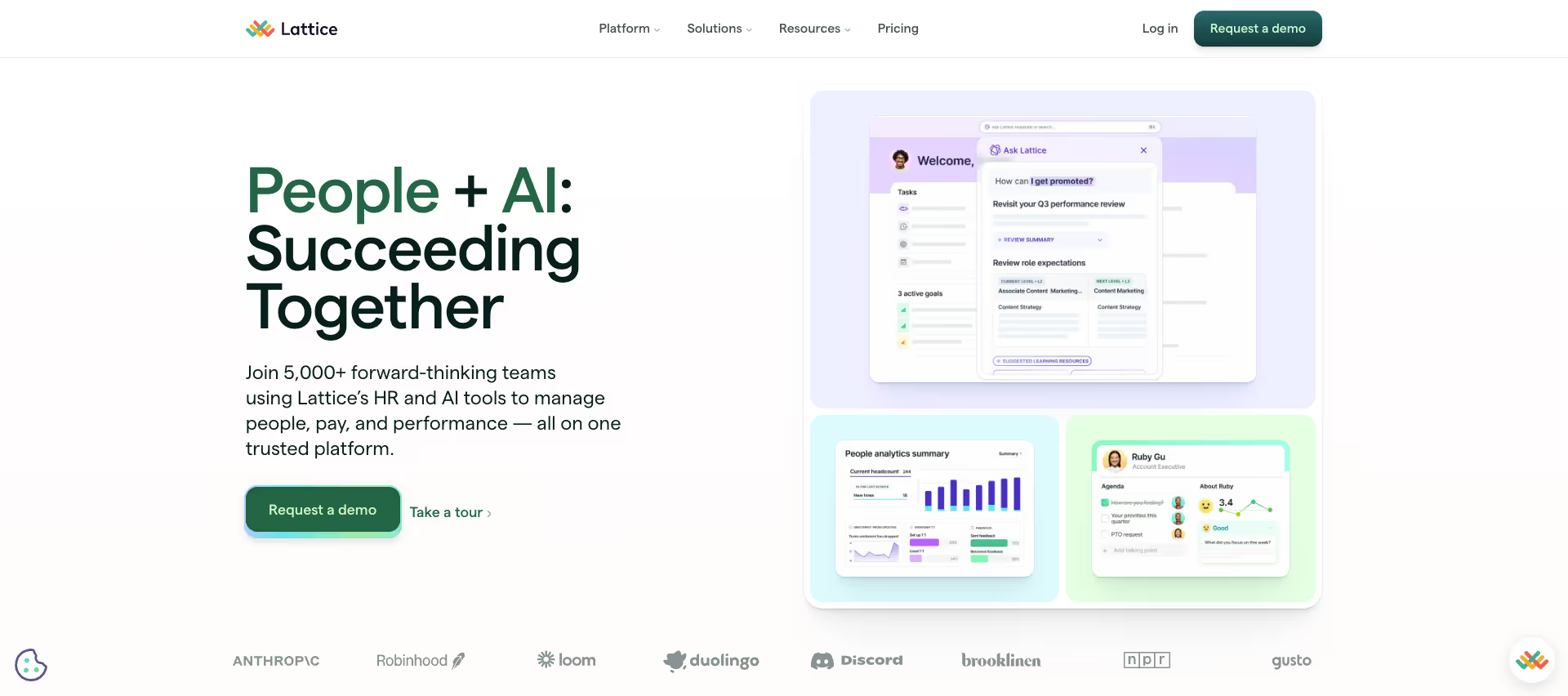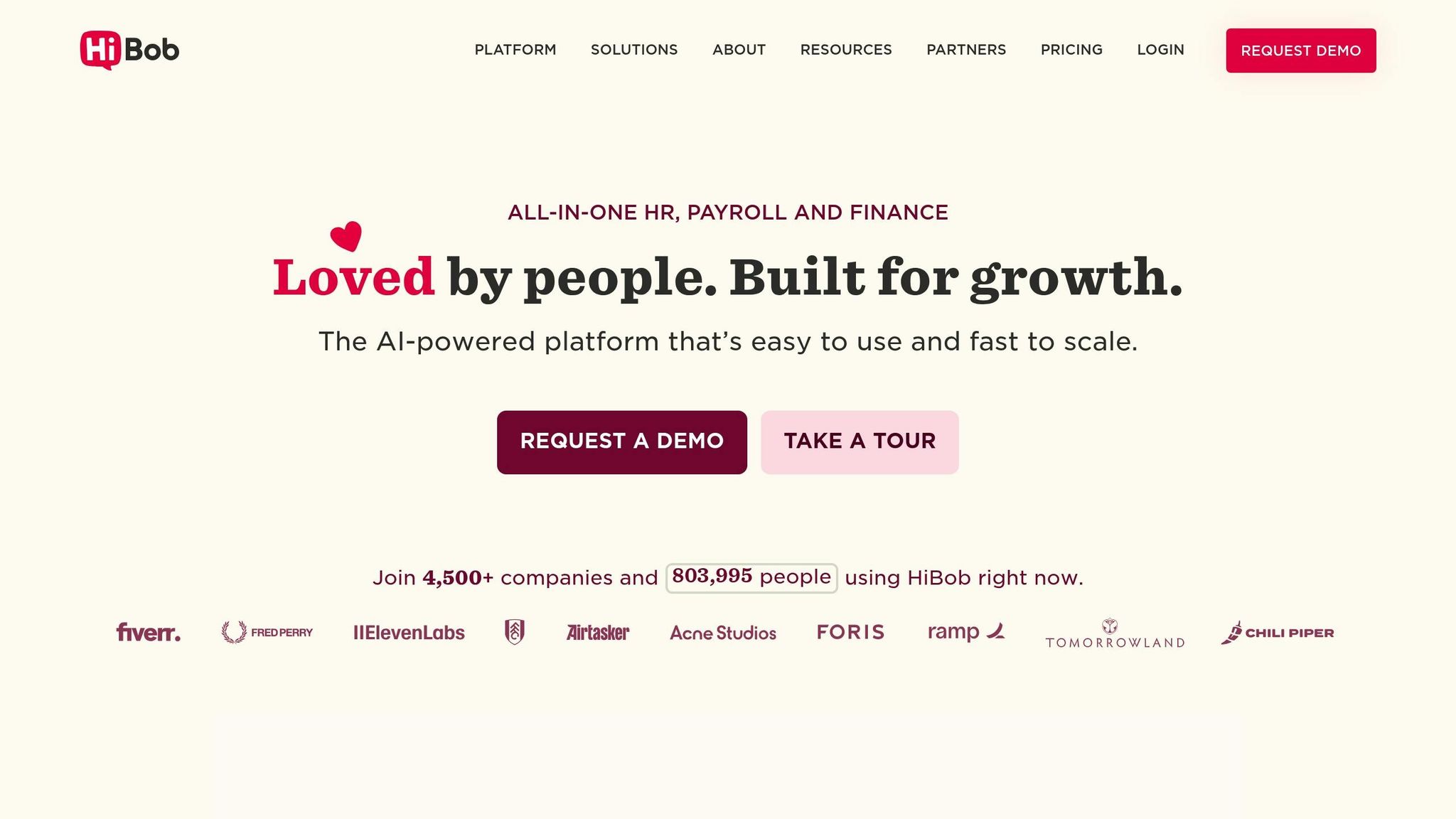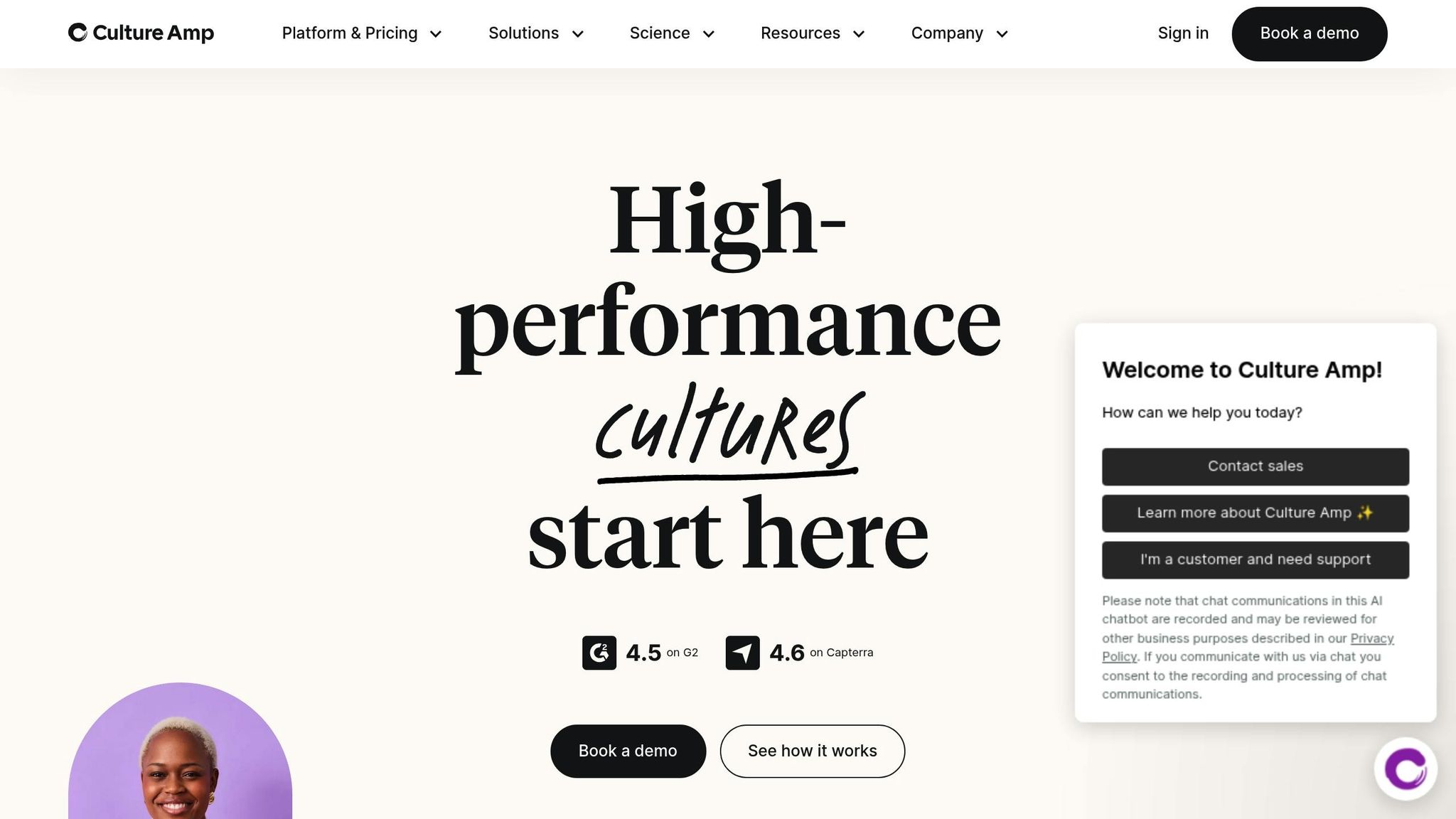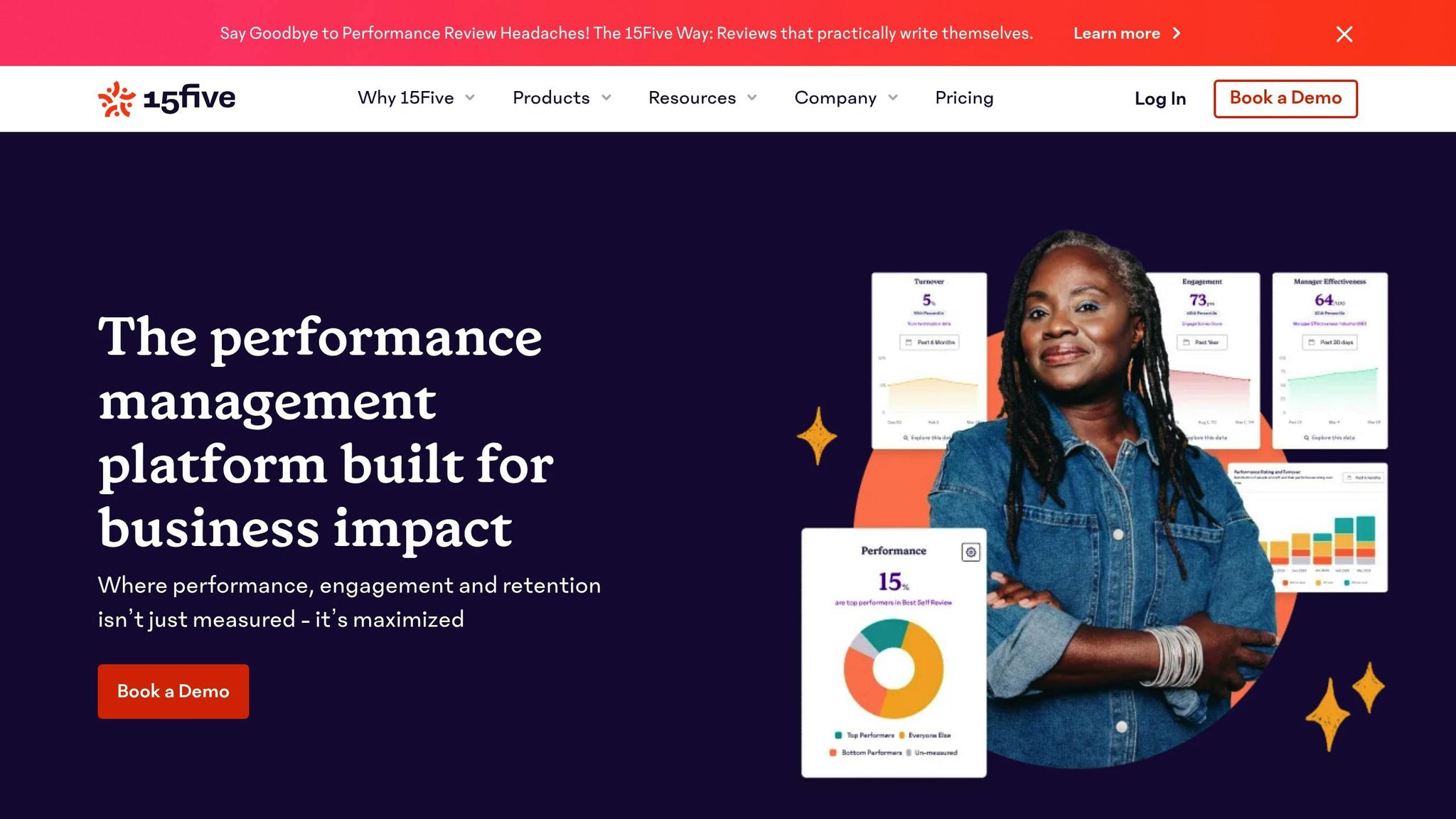Lattice HR Review 2026: A Deep Dive Into Features, Pricing, and Competitors

Lattice is a popular HR platform designed for businesses looking to integrate performance management, employee engagement, and career development into one system. It’s best for mid-sized to large companies, offering tools like real-time feedback, engagement surveys, compensation planning, and career growth insights. However, it may be too complex or costly for smaller teams.
Here’s how Lattice compares to its competitors:
- Lattice: Best for mid-sized to large organizations seeking integrated HR tools with AI-driven analytics. Pricing is customized but can be expensive.
- HiBob: Combines HR, payroll, and compliance in one platform, ideal for global operations. Pricing ranges from $16–$25 per employee/month.
- CultureAmp: Focuses on engagement analytics and performance metrics. More affordable at $5–$12 per employee/month but lacks core HR features.
- 15Five: Simple, budget-friendly option for smaller teams, priced at $4–$16 per employee/month. Limited scalability and fewer advanced features.
Quick Comparison
| Platform | Best For | Pricing (per employee/month) | Key Features | Limitations |
|---|---|---|---|---|
| Lattice | Mid-sized to large companies | Custom | AI analytics, performance, engagement tools | Expensive, complex setup |
| HiBob | Global mid-sized businesses | $16–$25 | Payroll, compliance, and HR in one system | Limited specialization, higher cost |
| CultureAmp | Engagement-focused organizations | $5–$12 | Engagement analytics, benchmarking | No payroll or HRIS features |
| 15Five | Small teams | $4–$16 | Feedback tools, simple performance reviews | Lacks advanced tools for larger teams |
Choosing the right platform depends on your company’s size, budget, and HR priorities. Lattice offers a strong all-in-one solution for larger organizations, while smaller teams may prefer simpler, more affordable options like 15Five.
Lattice Review: Top Features, Pros & Cons, and Alternatives
1. Lattice
Lattice has become a global player in the world of people management, offering a platform that brings together performance management, employee engagement, and career development into a cohesive system. This approach has helped it serve thousands of customers worldwide, emphasizing its mission to create a unified experience for HR teams and employees alike.
Features
At the heart of Lattice's platform is its Talent Management Suite, which focuses on five essential areas: Performance, Engagement, Compensation, OKRs & Goals, and Grow. Here's a closer look at what each of these offers:
- Performance: Facilitates ongoing feedback through real-time check-ins, one-on-one meeting templates, and flexible review cycles.
- Engagement: Uses anonymous surveys and pulse checks to gauge employee sentiment and flag potential concerns before they escalate.
- Compensation: Offers tools for salary planning, equity distribution, and pay transparency, with benchmarking capabilities to help companies stay competitive in the market.
- OKRs & Goals: Aligns individual and team objectives with broader organizational priorities, promoting accountability across all levels.
- Grow: Focuses on career development by offering employees and managers actionable insights for skill-building and growth.
Beyond these, Lattice also includes HRIS tools for managing employee records, onboarding workflows, and detailed reporting. Looking ahead, the addition of Payroll and Time Tracking tools - set to launch in early 2025 - will further expand its capabilities.
AI-powered features like a digital assistant and personalized coaching are another highlight. These tools simplify decision-making by providing automated insights, suggesting tailored development plans, and helping managers make data-driven choices. Together, these features position Lattice as a strong contender in the people management space.
Pricing
Lattice follows a customized pricing model, meaning potential customers need to request a demo to receive a personalized quote. Pricing depends on several factors, including the number of employees, the modules selected from the Talent Management Suite, the inclusion of HRIS functionality, and the desired level of AI features.
This flexibility allows organizations to start small - perhaps with core performance management tools - and expand over time by adding engagement surveys, compensation planning, or advanced analytics as their needs grow. This modular approach aligns with trends in the HR tech space, where 55% of HR teams are actively working to consolidate their tech stacks to manage budgets more effectively [1].
Ideal Use Cases
Lattice is particularly well-suited for mid-sized to large organizations that value employee-centered cultures and rely on data to drive HR decisions. Companies with 100 to 5,000 employees are typically the best fit, as they can fully utilize the platform's advanced tools without overwhelming their teams.
Remote and hybrid teams also stand to gain a lot, as Lattice's engagement monitoring and feedback features help maintain alignment and connection, even when employees are scattered across locations. For businesses experiencing rapid growth or those looking to formalize their HR processes, Lattice offers scalable templates and workflows that simplify the transition.
Industries like tech, professional services, and other knowledge-driven fields often find Lattice particularly effective, as employee engagement and development directly influence their success.
Limitations
While Lattice offers a robust set of features, it may not be the best choice for smaller organizations with limited HR resources. For companies with fewer than 50 employees, the platform's depth might feel excessive, and simpler, more budget-friendly options could be a better fit.
The setup process can also be time-consuming, especially for organizations implementing multiple modules at once. This may pose challenges for teams with limited bandwidth to handle complex configurations.
Another potential drawback is pricing. Although Lattice doesn’t make its rates public, its solutions often require a significant annual commitment, which might be out of reach for startups or small businesses with tight HR budgets. In fact, 39% of low-performing teams cite budget constraints as a major hurdle [1].
Finally, while Lattice's new HRIS tools add value, they don't fully replace traditional HRIS systems. Companies with intricate payroll needs, benefits administration, or strict compliance requirements may still need additional software, which could reduce the benefits of consolidating tools. Smaller teams might also face challenges with adoption, including resistance to change and limited training resources, which could impact how effectively the platform is used.
Overall, Lattice's comprehensive approach makes it a strong choice for mid-market organizations, but smaller teams may find it unnecessarily complex or costly for their needs.
2. HiBob

HiBob takes a broader approach to HR management compared to Lattice's specialized focus. It provides an all-in-one platform that combines HR, payroll, and finance solutions, tailored specifically for mid-sized businesses [3].
Features
HiBob's platform is designed to serve as a complete HR ecosystem, offering tools for performance management, engagement surveys, onboarding, people analytics, and even culture tracking [4]. Instead of relying on separate modules, HiBob integrates these features into a single system, allowing businesses to handle employee records, payroll, performance reviews, and engagement monitoring seamlessly.
One standout feature is its ability to consolidate core HR functions in one place. Unlike many platforms that require separate systems for payroll and benefits, HiBob provides these capabilities under one roof. Additionally, it emphasizes global functionality, making it an appealing choice for businesses operating outside the United States. The platform includes localized compliance tools and multi-region support, addressing the unique challenges of international organizations.
Given its extensive capabilities, HiBob is particularly attractive to companies looking to streamline their HR processes while managing global operations effectively.
Pricing
HiBob does not publicly list its pricing [3]. However, industry insights and user feedback suggest that the platform typically costs between $16 and $25 per employee per month [3]. This pricing model covers the full suite of features, making it easier for companies to plan their HR budgets as they scale.
Ideal Use Cases
HiBob is ideal for mid-sized businesses that need a fully integrated HR solution, especially those with global operations or plans to expand internationally. Its global compliance tools and onboarding features make it a great fit for companies navigating multi-region complexities [3][4]. Organizations looking to simplify their HR tech stack will benefit from HiBob’s ability to centralize multiple functions into one system.
As Teamspective notes [4]:
HiBob does more than Lattice. It's a better fit for companies that want one system for many HR needs.
This makes HiBob a strong option for businesses aiming to reduce vendor management headaches and integration challenges while maintaining a comprehensive HR solution.
Limitations
While HiBob’s all-in-one approach is a major strength, it may not be the best fit for every organization. Companies with highly specific needs in areas like performance management or employee engagement might find that specialized platforms offer more tailored solutions. Additionally, the pricing may feel steep for businesses that only require basic HR functions. Smaller startups or large enterprises with complex, niche needs might find HiBob either too robust or not flexible enough to meet their requirements.
3. CultureAmp

CultureAmp stands out as a platform designed to connect employee satisfaction with measurable business outcomes. Unlike broader HR software solutions, it specializes in engagement analytics, making it a go-to choice for companies that rely heavily on data to drive decisions [3][5].
Features
At its core, CultureAmp delivers research-backed insights to uncover the key drivers of employee performance. It offers advanced engagement data combined with benchmarking tools, enabling businesses to compare their metrics against industry standards.
One of its standout features is the integration of performance reviews with engagement data. This connection allows companies to directly link employee satisfaction to individual and team performance. Additionally, its action planning tools help translate survey results into practical steps, offering guided frameworks to address challenges and track progress effectively.
These capabilities make CultureAmp a strong contender for organizations seeking in-depth analytics without the complexity of broader HR platforms.
Pricing
CultureAmp uses a per-employee pricing model, with costs ranging from $5 to $12 per employee per month [3][5]. Exact pricing depends on the specific needs of the organization and is available upon request [3][5].
This structure positions CultureAmp as a more cost-effective option compared to comprehensive HR suites, while still delivering powerful analytics for businesses focused on employee engagement and performance.
Ideal Use Cases
CultureAmp is particularly well-suited for mid-sized companies that prioritize understanding the link between engagement and performance [3][4]. It’s an excellent choice for organizations aiming to leverage data-driven insights to improve employee experience and business outcomes [4].
The platform works best for businesses that have already implemented basic HR processes and are now looking to elevate employee engagement through detailed analytics. It’s especially beneficial for companies with a strong focus on metrics and those looking to benchmark their engagement data against industry standards.
However, this specialized focus does mean there are certain limitations.
Limitations
While CultureAmp excels in engagement analytics, it lacks core HR functionalities like HRIS or payroll management [3][5]. This means businesses will need additional systems to handle tasks such as employee records, benefits administration, and payroll processing.
For organizations seeking an all-in-one HR platform, CultureAmp’s narrow scope might feel restrictive. Similarly, companies with simpler engagement needs may find its analytical depth unnecessary for their current stage of growth.
Ultimately, CultureAmp is best suited for data-driven companies that want to optimize employee experience through advanced insights. However, businesses requiring a full HR solution will need to pair it with complementary tools.
sbb-itb-88a7fe6
4. 15Five

After exploring Lattice, HiBob, and CultureAmp, 15Five emerges as a more streamlined option designed specifically for smaller teams. It’s a performance and engagement platform that emphasizes continuous feedback and simple reviews, making it a great fit for organizations looking for essential tools without the complexities of enterprise-level systems.
Features
15Five focuses on creating a framework for ongoing feedback and lightweight performance management. Its standout features include:
- Regular check-ins and simplified performance reviews to keep communication flowing.
- Integrated 1:1 meeting tools and the Best-Self Review, providing structure for meaningful evaluations.
- A career hub to support employee development and an HR outcomes dashboard for tracking trends.
- A manager effectiveness indicator to highlight areas where coaching might be needed [2].
- Engagement-boosting tools like actionable surveys and "High Fives" for peer recognition.
This focused approach ensures that smaller teams get the tools they need without unnecessary complexity.
Pricing
15Five offers an affordable pricing model, with costs ranging from $4 to $16 per employee per month [3]. Its pricing reflects its streamlined feature set, making it a budget-friendly choice for teams that don’t require advanced modules like compensation planning or deep analytics.
Ideal Use Cases
15Five is perfect for startups or growing companies that want to prioritize continuous feedback and lightweight performance reviews. Its straightforward tools make it easy to build regular feedback loops without getting bogged down in overly complex systems [3].
Limitations
While 15Five excels at providing essential feedback tools, its simplicity can be a drawback for larger organizations or those with more complex needs. It lacks advanced features like detailed analytics, robust goal management, and integrated compensation planning. For companies looking for AI-driven insights, benchmarked engagement data, or sophisticated performance calibration tools, 15Five might not scale effectively. These limitations set it apart in a competitive market.
Platform Advantages and Disadvantages
User feedback from 2026 sheds light on the strengths and weaknesses of each platform. Here's a quick overview:
| Platform | Key Advantages | Main Disadvantages |
|---|---|---|
| Lattice | • AI-powered analytics with personalized coaching insights • Smooth integration across performance, engagement, and compensation tools • High adoption due to user-friendly design |
• Analytics not as deep as specialized HR data platforms • Higher price point compared to simpler HR tools • Complex setup when using multiple modules |
| HiBob | • All-in-one HR solution with payroll and benefits • Global compliance features for multi-region support • Simplifies vendor management with a single system |
• May fall short in specialized HR functions • Pricing can be steep for basic HR needs |
| CultureAmp | • Engagement insights backed by research and industry benchmarks • Links employee satisfaction directly to performance metrics • Affordable option for engagement-focused strategies |
• Lacks core HR features like HRIS and payroll • Limited scope requires additional systems to fill gaps |
| 15Five | • Cost-effective for essential HR tools • Easy setup for smaller teams • Encourages continuous feedback with minimal complexity |
• Not ideal for larger organizations due to scalability issues • Missing advanced analytics and compensation planning features |
Lattice stands out for integrating performance reviews, continuous feedback, and career development, making it a great fit for organizations focused on building high-performing teams. However, its all-encompassing features come with a higher price tag and a more involved setup process. This summary offers a clearer picture of how each platform aligns with different organizational goals and growth stages.
Conclusion
In 2026, Lattice stands out as a top-tier HR platform, particularly for its strengths in people analytics and performance management. With features like performance reviews, goal tracking, and engagement tools all in one place, it simplifies HR workflows and helps businesses stay organized.
Its user-friendly design makes it a go-to solution for mid-market companies aiming to scale their HR operations effectively. While its higher price point might not suit smaller teams, the platform's extensive capabilities make it a worthwhile investment for organizations focused on growth.
Competitors such as HiBob, CultureAmp, and 15Five cater to specific needs, but Lattice's all-in-one approach remains unmatched.
Ultimately, selecting the right HR platform depends on your company's size and goals. Established organizations with advanced HR processes can fully leverage Lattice's powerful analytics and integrations. On the other hand, startups or smaller businesses may find simpler, more affordable options better suited to their current needs.
With its comprehensive tools and data-driven approach, Lattice continues to lead the way in modern HR management, making it a standout choice for HR leaders in 2026.
FAQs
What should mid-sized companies evaluate when considering Lattice as their HR platform?
Mid-sized businesses might find Lattice to be a valuable solution, thanks to its ability to combine performance management, employee engagement, and development tools into a single platform. With its intuitive interface, flexible workflows, and real-time analytics, it’s designed to grow alongside expanding teams.
What sets Lattice apart is its emphasis on continuous feedback, goal alignment, and actionable insights, which can help organizations build a high-performance culture. For companies that put people at the center of their strategies, Lattice provides tools that not only enhance operational efficiency but also promote employee development.
How is Lattice priced, and what determines the cost for a company?
Lattice offers a flexible pricing structure built around a per-user-per-month (PEPM) subscription. The final cost varies based on a few key factors, such as the size of your team, the modules you select (like performance management, engagement, or compensation tools), and the duration of your contract.
For most organizations, pricing typically falls between $4 and $11 per user each month. However, advanced modules or custom integrations may come with additional fees. Larger businesses or those with specific requirements often work out tailored plans, which are usually tied to multi-year contracts.
What challenges might smaller businesses face when using Lattice, and how can they overcome them?
Smaller businesses might find Lattice a bit of a stretch due to its higher price point compared to simpler HR tools, the complexity involved in setting up its advanced features, and the absence of payroll and benefits management. For teams with tight budgets or limited HR resources, these factors can feel like a significant hurdle.
To work around these challenges, businesses can start by focusing on the Lattice modules that address their most pressing needs. Leveraging Lattice’s onboarding support, training materials, and customer assistance can also make the setup process smoother and ensure teams get the most out of the platform. For smaller teams, opting for a basic plan initially and scaling up as their needs evolve could make Lattice a more practical and manageable choice.
Related Blog Posts
Read also
Ready to get started?
If you want to dive into the details just Book a Free Consultation with our staff and we’ll be happy to answer your questions.





